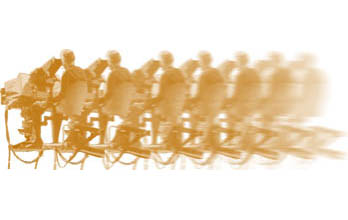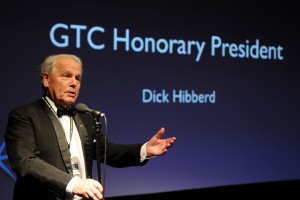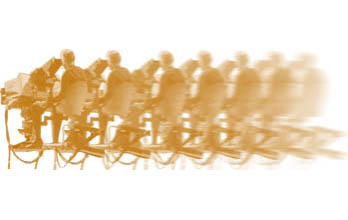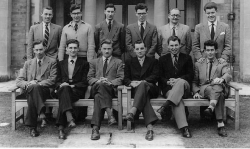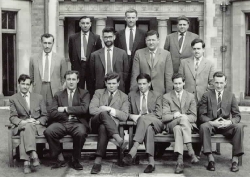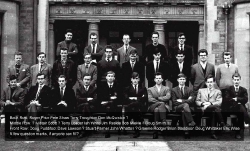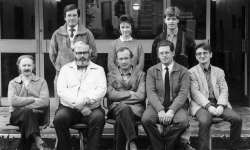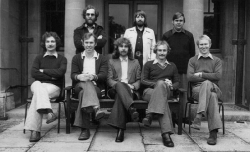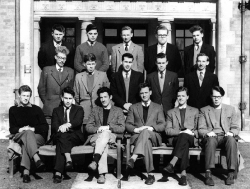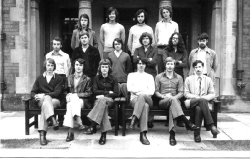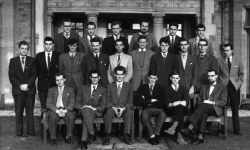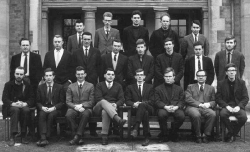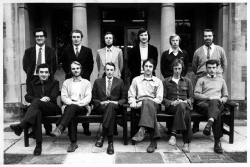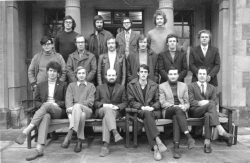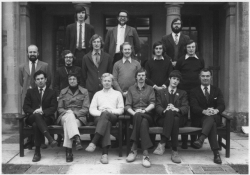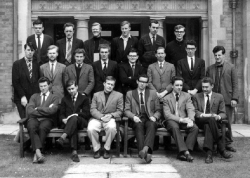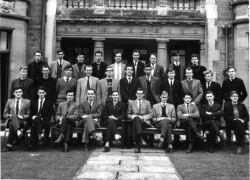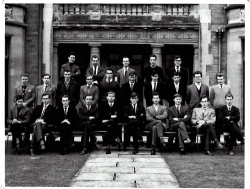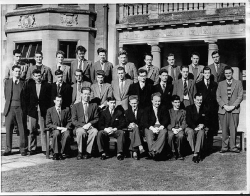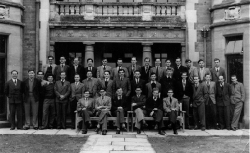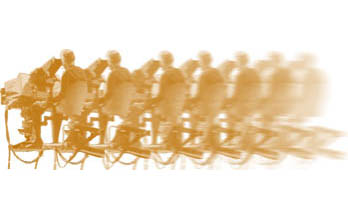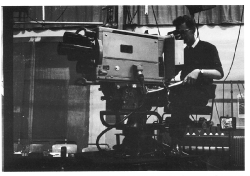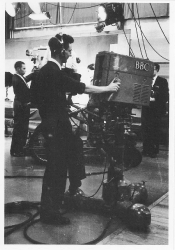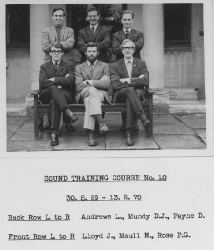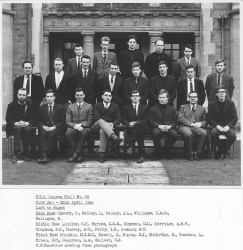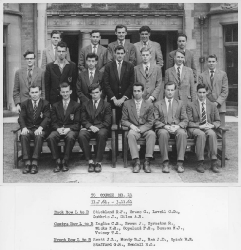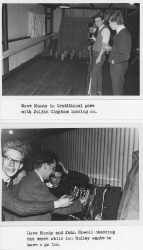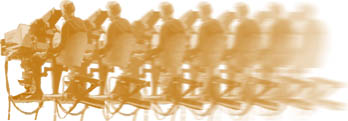A few memories of Riverside Studios by Peter Ward
I was hoping that recent trawls for missing BBC programmes would unearth 35mm copies of ‘Troubleshooters’, the BBC drama series about the oil industry. In the mid-sixties I took part in a short lived BBC trial using 35mm Arriflex cameras with an industrial type vidicon camera bolted to the side deriving its image from, I believe, a special mirror shutter fitted to the Arris. I think a similar system using Mitchell cameras had been called ‘AdVision or ‘AdiVision’.
The intention was to produce ‘Troubleshooters’ in the normal way a two day rehearse/recording using three cameras as if recording on tape but instead of a video tape master, the end result was to provide a 35mm film copy that could be sold overseas without the degradation of converters. The recording took place at Riverside Studio 1 and the show was rehearsed and shot as a multi camera production.
The vision mixer cut between the nonbroadcast industrial cameras to provide a video ‘guide’ track whilst also running the Arriflex cameras just before each shot was taken. Her job was to economise on film and therefore she would run the appropriate film camera from the gallery just before it was required and when it was up to speed, cut to the industrial vidicon then run the next film camera, cut to that, and then stop the first camera. On a fast cutting sequence the cameras were left running but the system hiccup from the cameraman’s point of view was that as the film camera got up to speed his picture, derived from the shutter, broke up completely and only settled mini seconds before the shot was to be used. At the crucial moment when the shot was needed, after repositioning and framing, the viewfinder picture broke up and by luck and by golly you hoped that it was sharp and framed at the point the picture settled and you were instantly cut to. Film from all the cameras were then edited against the ‘non-broadcast’ video master.
But as cameramen, our troubles did not end there. The 35mm Arriflex, heavily blimped, were hefty items to crab and crane around on their peds. We attempted to shoot ‘Troubleshooters’ with normal video camera development but found it an uphill struggle. When we saw the finished result the film from the three cameras edited together and projected on a normal cinema screen we discovered even worse problems. The low quality industrial cameras provided a low quality viewfinder and the focus zones were so much more obvious on a large projected image than they had been in the viewfinder. Any camera movement on shot jumped and bumped over Studio 1 floor and that gave us cause for concern as well.
The condition of Riverside Studio 1 floor was the result of a number of ‘tough’ productions across it in the preceding years such as ‘Six Five Special’. There was a musical called ‘Carissimia’ with Ginger Rogers and David Hughes set in Vienna complete with mini canal and Gondolier – the canal leaked during transmission.
And there was a Western (I think starring Rod Steiger) using Studio One and Two. I believe the production could only afford one horse so it was constantly led back and forth at the end of the western street in long shot.
Hancock, Quatermass, Dixon of Dock Green and an ill-fated weekly soap ‘Starr & Co’ also came from Riverside.
A rowdy gang of teddy boys once threatened to disrupt a live transmission of Six Five Special. Their favourite “joke” was to stand on camera cables and bring you to a shuddering stop. An enterprising floor manager a few minutes before transmission ran into Studio Two where Dixon was being rehearsed to follow on from Six Five and enlisted the help of a number of police “extras”. The South Kensington actors in uniform enjoyed their moment of glory and cleared the offending teddy boys out of the studio.
Riverside Studios, before TV Centre was opened, was better equipped than the Grove and was certainly a more pleasant place to work. There was a terrace outside Studio 1 overlooking the Thames which was a favourite ‘resting’ place during summer afternoons. It was often used to mount a camera for the Boat Race but for one edition of Barry Bucknell’s ‘Do It Yourself’ programme, the director put a camera out on the terrace. The programme often started with a shot of the item that Barry was going to build or repair. For this edition, the camera panned across Hammersmith Bridge at the top of the show, no doubt attracting considerable interest from doityourself enthusiasts across the UK who fancied themselves as hardboard bridge builders.
Barry was known by sound mixers as the hesitant hammer. He had a trick of starting a sentence, raising his hammer as if to strike thereby causing the sound mixer to pull back the fader to avoid an overload. Barry would then speak a few words to finish his sentence forcing the sound mixer swiftly to bring the mod back up again just at the moment Barry crashed the hammer down wrapping the PPM needle around the end stop.
++++++++++++++++++++++++++
The First Time I Tracked a Mole Crane by Roger Bunce
1965. I was a very junior trainee Dolly Operator, newly arrived at TV Centre. And I hadn’t been to Evesham yet, so my ignorance of all things technical was profound. I was rigging in Studio E, Lime Grove, when I received an urgent call from Allocations. Could I go immediately to the Studio next door, where the Crew were short handed?
I hastened to Studio D. It was “Blue Peter”. The Crew had rigged and rehearsals were just beginning. They urgently needed someone to track the Mole Crane. I hurried to the Mole. The Cameraman was Mike Figini. He was offering a Wide Shot of presenter Christopher Trace, who was sitting in a mock-up of a tube train.
Even as I climbed aboard Mike was signalling me to track in to a closer shot. I had never used a Mole before, nor even seen one, and, having missed the rig, I had had no opportunity to ask anyone about it. I quickly checked the controls. It all seemed straightforward enough; two throttle levers and a steering wheel.
Then I looked for the “Dead Man’s Handle”. The only dollies I had tracked before were the Heron and the Vintern Motorised. Both of these have a Dead Man’s Handle, i.e. a pedal on the Tracker’s platform, which had to be held down by the Tracker’s bodyweight in order to activate the motor. It worked as a safety cutout. Should the Tracker dismount or fall off the platform, the pedal would be released and the motor would immediately be disabled. I saw a bar, just in front of my toes. I put my foot on it and it depressed satisfactorily. Clearly, this was a pedal. It must be the Dead Man’s Handle.
Thus after a split-second’s self-training, and feeling that I knew what I was doing, I attempted to track in. I put my foot down firmly on the pedal and pushed the throttles forward. The whole crane shuddered and trembled. Then it began to move forward, very slowly, in a series of jerks and twitches. Despite holding the pedal down with my full bodyweight and pushing both throttles fully forward, the Mole was only managing a very reluctant, stuttering movement. Everyone was staring at us, puzzled. Evidently there was a fault on the crane, but we would sort that out later. The priority now was to line up the shot.
After a long embarrassing judder, Mike Figini felt that the shot was tight enough and signalled me to stop. So – I took my foot off the pedal – – –
The crane shot forward like a rocket.
Instinctively I stamped my foot down again, and pulled back the throttles. We stopped violently, but not before Mike’s Mid-Shot of a smiling Chris Trace had crashed into a Big Close Up of a terrified Chris Trace! We had almost pinning him against the set. To his credit, Mike held focus remarkably well. And, once he had recovered from the shock, Chris Trace thought the whole thing was very funny. In this drastic way, I first learned that a Mole Crane does not have a Dead Man’s Handle – just a brake.

